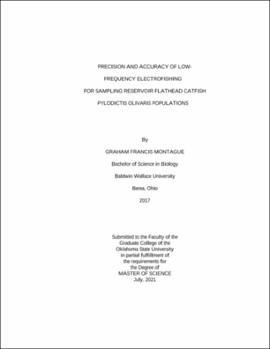| dc.description.abstract | Flathead Catfish Pylodictis olivaris are popular among anglers, however; information about sampling Flathead Catfish is limited. Low-frequency electrofishing (LFE; < 30 pulses per second [pps]) is the most commonly used method for sampling Flathead Catfish. Therefore, the precision, optimal sampling duration, and accuracy of LFE sampling for Flathead Catfish was evaluated. CPUE (all sizes combined, CPUETotal; fish over 610 mm TL, CPUE610; and fish over 710 mm TL, CPUE710) was highest from May-September when the water temperature was >23 degrees C. Precision estimates (relative standard error, RSE) were not significantly impacted by water temperature but varied by month. CPUETotal, CPUE610, and CPUE710 and their precision estimates did not significantly differ between 5-, 10-, and 15-minute samples. At warmer temperatures (i.e., >23 degrees C), 15-minute samples only required 10-16 samples whereas 5-minute samples required 14-23 samples to achieve RSE = 25. Using a known Flathead Catfish populations (i.e., fish marked in Lake Carl Blackwell, Lake McMurtry, and Boomer Lake with operculum Carlin Dangler tags), I calculated capture probabilities with a Cormack Jolly Seber model. LFE is size biased but the bias varied among lakes. Capture probability decreased as fish length increased in Lake Carl Blackwell and Lake McMurtry and increased as fish length increased in Boomer Lake. Capture probability was the highest in July for Lake Carl Blackwell and Boomer Lake and August for Lake McMurtry. Capture probability was highest when the water temperature was >26 degrees C in both Lake Carl Blackwell and Lake McMurtry, but temperature was not in the top models from Boomer Lake. The probability of a fish surfacing in wetlab trials was inversely related to the power applied to the fish indicating that low power application is most successful for Flathead Catfish LFE. Only 9.8% of fish surfaced in the trials suggesting that only some fish exhibit a surfacing response when exposed to LFE. I recommend sampling Flathead Catfish in July and August when the water temperature is >26 degrees C as this sampling design will maximize catch rates, have high precise and minimize the size bias during the sampling season. | |
